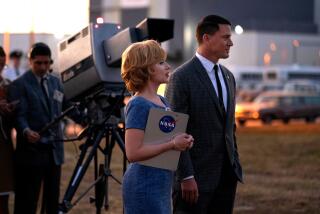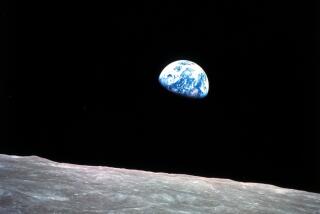Mercury 7: Rare Breed of Heroes
- Share via
Next week marks the 20th anniversary of man’s first landing on the moon. There will be many interviews with Neil Armstrong and Orange County’s Buzz Aldrin--the two astronauts who first set foot on the lunar surface. But there will probably be little or no remarking on one of the great ironies of this historic act: that it was performed by members of the astronaut second team rather than the men who caught the imagination and admiration of virtually all Americans a decade earlier as the seven Mercury astronauts.
Those of you who are old enough to remember will recall that the original seven astronauts were canonized in Life magazine for many years as the result of a lucrative and exclusive personal contract--later roundly criticized--with that magazine.
As far as I know, I was the only writer to break through the Life barrier and spend appreciable time with the Mercury astronauts during those early years of space exploration. I spent a month with them at Langley Field in Virginia and wrote a book called “Seven Into Space.” I interviewed individual members of this group on a number of other occasions for some years afterward. Then, a decade ago, I submitted a second book proposal called “The Last American Heroes.” With uncanny timing, it arrived in New York a few months after Tom Wolfe had preempted the subject with a contract for “The Right Stuff.”
The thesis of the book I wanted to write--and one I still believe--is that with the possible exception of John F. Kennedy, the Mercury astronauts were the last men that Americans looked on and strove to emulate as heroes. The courage it took to allow themselves to be rocketed into space in a “tin can” not much bigger than a bathtub fascinated millions of Americans. And the shift of this country into a kind of national cynicism and occasional despair paralleled the recognition that these seven men were--like the rest of us--flawed human beings.
None of them opted for the role of hero, and it was a burden few men are equipped to carry. Yet, we tend to expect it of public figures to whom we assign that role. The Mercury Astronauts were the ultimate prototypes of the WASP culture that has always ruled America’s power structure--and still does, although a little more tenuously. All seven were raised in small American towns; all had at least one brother or sister; all were white and Protestant; all came from middle- to upper-middle-class homes; all were former combat pilots in one of America’s holy wars, and all were in superb physical condition, strongly motivated and apparently highly self-assured.
But at the time of their selection, the seven original astronauts were military test pilots and engineers, not icons. They generally did their thing magnificently in space, but--prodded by eager NASA flacks--we expected much more than that of them. And when they revealed themselves as human, after all, a lot of Americans somehow felt cheated. What has happened to these seven men since they were thrust on the public scene as Space Supermen demonstrates that fact rather vividly.
Virgil Grissom almost washed out of the program because of chronic hay fever. As it turned out, that would have saved his life. Gus Grissom died on the launch pad of Apollo I, along with his two co-pilots in the first space disaster in American history.
The other six original astronauts today represent a broad range of success and failure.
John Glenn flew the first orbital mission, then resigned from NASA to run for the U.S. Senate. He failed twice, and in the process suffered a severe inner ear injury when he fell--in of all places--a hotel bathtub. He made the Senate on his third try and is now regarded as a senior statesman.
Alan Shepard, the first American in space, was also the only member of the original seven astronauts to get to the moon. Shepard was grounded before his second mission by an inner ear problem similar to that of Glenn. He stayed in the program as chief of the astronaut office, became a confidante of Texas millionaires, and made a fortune in the stock market and Texas real estate while battering NASA doctors to return him to flight status.
When he finally won his point, he immediately installed himself as the commander of Apollo 14, the third moon landing, and made his second flight into space 10 years after his first, at the age of 49.
Deke Slayton, prototype of the hell-for-leather combat pilot, waited the longest of the original seven for a trip into space. He was to follow John Glenn’s first orbital mission but was grounded by a heart murmur a month before his scheduled flight. Like Shepard, he never stopped pressuring NASA doctors to reverse that verdict while he served as director of flight crew operations. Finally, at the age of 50, he was reinstated to flight status and named himself as part of the crew of Skylab 4 that rendezvoused with the Russians in July, 1975. When Slayton left NASA the next year for a career in industry, the original seven lost their final clout in the space program.
Of the remaining three Mercury Astronauts, Wally Schirra’s experience was the most straightforward. The son of a pair of barnstorming pilot-parents, Schirra flew three highly successful orbital missions before retiring from the space program in 1970 to found an environmental-control company, a field in which he works successfully today.
Scott Carpenter and Gordon Cooper were the most troubled of the original seven. Carpenter, an introspective and sometimes painfully candid man, flew only one mission that was badly flawed when he overshot his landing area by 200 miles. He lost his flight status several months later when he was injured in a motorbike accident and left the space program to work with the Navy’s Sea Lab and then--after his marriage failed--drift about in a series of mostly unsuccessful business ventures.
Today, still puzzled over image problems that recently cost him a job as spokesman for MasterCard International, he is apparently happily remarried and prospering as a lecturer and technical consultant.
And, finally, the baby of the original astronauts, Gordon Cooper, made one successful orbital flight and then was pushed to the back burner of the space program where he spent more and more time racing speedboats and stock cars--which further alienated his NASA bosses.
When he was bumped as commander of an Apollo mission, Cooper quit the program, went through a divorce and started an engineering firm, which allowed him to race his boats and cars. Since then, he’s settled into some high-powered Establishment jobs, including director of research for Walt Disney Co.
So while you’re listening to Armstrong and Aldrin being interviewed or reading about them, tip a glass to the seven who got it all started--and weren’t around for the biggest “step” of all: to the surface of the moon.
More to Read
Sign up for our Book Club newsletter
Get the latest news, events and more from the Los Angeles Times Book Club, and help us get L.A. reading and talking.
You may occasionally receive promotional content from the Los Angeles Times.










